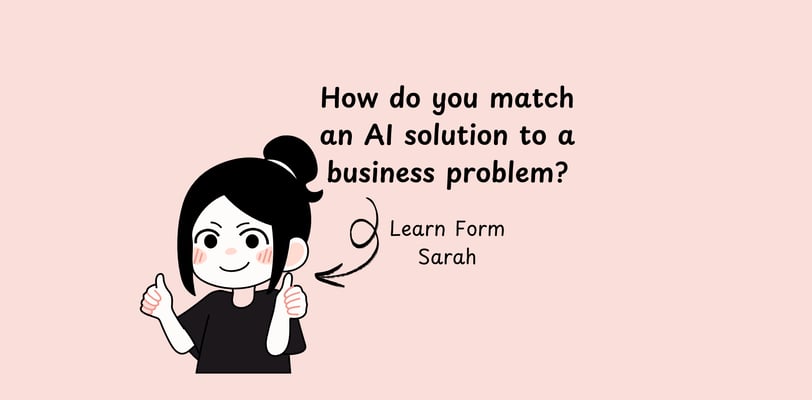How do you match an AI solution to a business problem?
5 questions every business owner should ask
AIBUSINESSAIFORSMALLBUSINESSSMALLBUSINESSAUTOMATION
4/7/20253 min read


It was a rainy Monday morning when Sarah, the CEO of a growing e-commerce startup, stared anxiously at her laptop screen. Sales had plateaued, customer complaints were rising, and her team was overwhelmed by repetitive tasks. She knew artificial intelligence could help, but the sheer number of AI solutions available left her feeling lost. "Where do I even begin?" she wondered, sipping her lukewarm coffee.
Sarah's dilemma isn't unique. Many business leaders find themselves intrigued by AI's potential yet unsure how to match the right AI solution to their specific business problems. Like Sarah, they face critical questions: How do we clearly define our business challenges? Which AI technologies align best with our goals? Do we have the right data and internal capabilities to support AI implementation?
Matching an AI Solution to Your Business Problem
To effectively navigate this challenge, it's essential to follow a structured approach:
Clearly Define the Business Problem: Identify precisely what issue you're trying to solve and how it aligns with your broader business objectives. For Sarah, this meant pinpointing specific pain points—such as inefficient customer service and inaccurate demand forecasting.
Set Specific, Measurable Goals: Use the SMART framework (Specific, Measurable, Achievable, Relevant, Timely) to establish clear objectives. Sarah's SMART goal became: "Reduce customer service response time by 30% within six months using an AI-powered chatbot."
Understand and Explore Different AI Technologies: Familiarize yourself with various AI methods—Machine Learning, Deep Learning, NLP, Predictive Analytics, Computer Vision, Automation, Generative AI, and Virtual Assistants—to determine which best addresses your problem.
Assess Internal Capabilities and Data Readiness: Evaluate your organization's existing technology infrastructure, employee expertise, and data quality. Sarah realized her company had ample customer interaction data but lacked internal AI expertise, prompting her to consider external partnerships.
Explore AI Implementation Options: Decide whether to develop AI solutions in-house, outsource development, or use off-the-shelf AI-as-a-Service (AIaaS) solutions. Given her startup's size and resources, Sarah opted for a cloud-based AIaaS solution.
Build a Strong Business Case and Evaluate ROI: Clearly articulate the expected outcomes, feasibility, and anticipated return on investment. Sarah defined clear KPIs—customer satisfaction scores, response times, and sales growth—to measure success.
Adopt an Experimental and Incremental Approach: Start small with pilot projects, test hypotheses, and scale incrementally based on results. Sarah launched a chatbot pilot project, carefully monitoring its impact before expanding its use.
Balance People, Processes, and Technology: Engage employees early, provide training, and address concerns proactively. Sarah ensured her team was involved from the start, fostering buy-in and smoother adoption.
How to Choose: The Five Questions You Should Ask
To confidently select the right AI approach, ask yourself these five critical questions:
What specific business problem are we trying to solve, and what are our clear, measurable goals for the AI implementation?
Clearly define your problem and set SMART goals to understand desired outcomes and AI's role in achieving them.
Do we have the necessary data in terms of volume, quality, and accessibility to support the chosen AI approach?
Evaluate your data foundation—ensure sufficient historical data, high quality, and robust data pipelines.
What are our internal capabilities and resources (technical expertise, infrastructure, budget), and what level of integration with existing systems is required?
Assess your organization's readiness, including technology infrastructure, employee expertise, budget constraints, and integration complexity.
Which types of AI technologies are most relevant to our business problem and goals, and what are the potential benefits and risks associated with each?
Match AI technologies to your specific problem, considering benefits (efficiency, customer experience, decision-making) and risks (privacy, ethical implications).
What is our proposed implementation strategy (e.g., pilot project, incremental scaling), and how will we measure the return on investment (ROI) and continuously improve the AI models and processes?
Plan your implementation strategy, starting with pilot projects and incremental scaling. Define clear KPIs to measure ROI and establish processes for continuous improvement.
By systematically following these steps and asking these critical questions, Sarah—and you—can confidently identify and implement AI solutions that effectively address specific business challenges, delivering tangible value and sustainable growth.
If you are a small business and need help with how you can integrate AI into your existing workflows, then check out our website or get in touch with us.
------------------------------------------------------------------------------------------------------------------------------------------------------------
References
1.https://firmbee.com/ai-technology
2.https://www.techtarget.com/searchenterpriseai/tip/10-steps-to-achieve-AI-implementation-in-your-business
3.https://inmoment.com/blog/how-to-use-ai-solve-business-problems/
4.https://hbr.org/2024/02/find-the-ai-approach-that-fits-the-problem-youre-trying-to-solve
